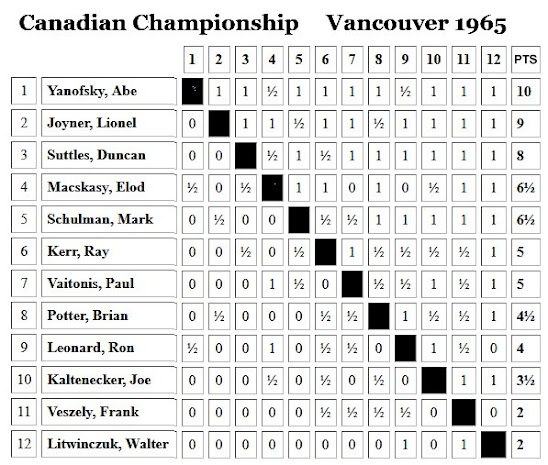In 1965, people were seeing were seeing changes in music, fashion and television. The British Invasion continued with groups like The Beatles and The Rolling Stones growing in popularity, Fashion saw the miniskirt and television offered a mix of wholesome family sitcoms and superhero like Batman.
The chess scene was highlighted by the Candidates Matches, a series of knockout matches to determine the challenger for the World Championship. The players were Spassky, Keres, Geller, Smyslov, Tal, Portisch, Larsen and Ivkov. Spassky won by defeating Keres, Geller and Tal.
Bobby Fischer didn’t participate because of his decision not to play in the 1964 Amsterdam Interzonal, the qualifying event. The disgruntled Fischer had previously accused Soviet players of collusion in the 1962 Candidates Tournament, an 8-player event where Fischer had finished 4eeth behind Petrosian (the winner) and Keres and Geller (tied). His accusations were well founded.
As a result, FIDE changed to the knockout matches, but, being the snot face he was, Fischer wasn’t satisfied. He still didn’t like the format and demanded specific playing conditions.
The Soviet Championship was won by Leonid Stein and veteran Soviet and renowned endgame composer Vitaly Chekhove passed away.
Fischer did play in the 1965 US Championship and won it even though he lost to Robert Byrne and Samuel Reshevsjy and was held to a draw by William Addison. He still finished a point ahead of Byrne and Reshevsky who were tied for second; Addison was 4th.
Up in Canada the veteran GM Dan Yanofsky of Winnipeg won the Canadian Championship over a strong 12-man field in Vancouver. There were several interesting games, including this one in which Duncan Suttles (born in 1945) defeated Joseph Kalteneck.
Suttles was born in San Francisco and his family bed to Canada when he was 8 years old. He was awarded the GM title in 1972 and retired from chess shortly thereafter to work on stock market analysis. Suttles was known for his unorthodox treatment of Hypermodern openings.
In this game he conducts a vigorous attack straight out of the opening and finishes with a nifty Rook offer that could neither be accepted nor declined.
[Event "Canadian Champ, Vancouver"]
[Site ""]
[Date "1965.06.25"]
[Round "?"]
[White "Duncan Suttles"]
[Black "Joseph Kaltenecker"]
[Result "1-0"]
[ECO "B25"]
[Annotator "Stockfish 17.1"]
[PlyCount "39"]
[EventDate "1965.06.21"]
{B23: Closed Sicilian} 1. e4 c5 2. Nc3 {A non-committal move that allows white
transpose omto the open variation whith d4 if he wishes, but usually by
playing this move white intends to follow a different path.} Nc6 {The most
common move, but not the only one. Black was, no doubt, expecting the usual 3.
g3, but against Suttles the unexpected had to be expected.} 3. g4 {Highly
unusual, risky; no surprise considerig it's Suttles manipulating the white
pieces.} d6 4. Bg2 g6 5. d3 Bg7 {What;s he going to play?! Some wild moves
that come to mins are 6.h4, g5 or the one actually played/} 6. f4 {The passive
6.h3 lacks gumption.} (6. Be3 Rb8 7. h3 b5 8. Qd2 Qa5 9. Nge2 h5 10. gxh5 Rxh5
11. f4 {Krausser,H (2166)-Reich,T (2394) Fuerth GER 1999. White has no
prospects of a K-side attack and black holds the advantage on the other side,
so it's no suprprise that he went on to win.}) 6... e5 {This counter in the
center is the correct response yo white's aggression on the K-side.} 7. f5 {
In addition to the text white could have also played 7.g5 or 7.h4} g5 {[%mdl
8192] It's hard to imagine how quickly disaster strikes after this move.
Suttles will open the h-file and the game will pretty much be over! After 7...
h5! white would have had no profitable reply.} (7... Qh4+ {is tempting, but it
fails to accomplish anything after} 8. Kf1 {and the Q will have to retreat
losing time after white plays Nf3}) (7... h5 {Now white;s best line is} 8. Be3
hxg4 9. fxg6 fxg6 10. Qd2 Qh4+ 11. Bf2 Qe7 12. O-O-O Be6 {White;s attack has
fizzled out and so black stands well.}) 8. h4 {[%mdl 512] Suttles is going all
out for the attack and is very close to winning.} h6 {This allows the opening
of the h-file and app the exchanhe of Rs and apparently reduces the virility
of white's attack, but that turns out not to be the case. Unfortunately, there
wasn't really anything better.} 9. hxg5 hxg5 10. Rxh8 Bxh8 11. Nf3 f6 12. Kf2
Qd7 13. Nd5 Qh7 {Somewhat better would have been 13...Nce7 adding a piece to
the defense of his K-side. 13...Qh7 looks plausible though because he doesn't
want white's Q to occupy the h-file unopposed.} (13... Nd4 {doesn't work out
too well after} 14. Qh1 Bg7 15. c3 Nxf3 16. Bxf3 {Black's pieces on the K-side
are tied up in a fashion similar to what happens in the game.}) 14. c3 Rb8 15.
Be3 Bg7 16. Qb3 {So, the R is going to h1. Note black's P on f6; it's well
gyarded...for the moment.} Bf8 17. Rh1 {[%mdl 32]} Qg7 (17... Qd7 {is even a
worse place for the Q.} 18. Rh8 Nce7 19. Nxe7 Nxe7 20. Nxg5 fxg5 21. Bxg5 Nc6 (
21... Qc6 22. Bh6 {wins}) 22. Bh6 {wins}) 18. Rh5 {Strongly threatening Nxg5!}
Nh6 (18... a6 {A pass to show the threat.} 19. Nxg5 fxg5 20. Rxg5 Qh8 21. Rxg8
Qxg8 22. Nf6+ {The previously mentioned weak f6 square.}) 19. Kg3 {A high
class waiting move.} Nf7 20. Rh7 {[%mdl 512] White resigned. Both 20...Qxh7
and 20...Qg8 are met bt 21.Nxf6+ winning the Q. An impressive crush by Suttles!
} 1-0



No comments:
Post a Comment